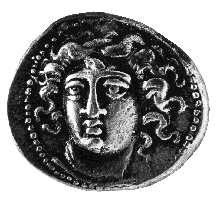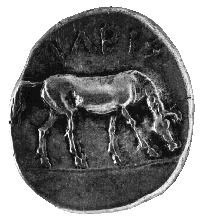



(28) Larissa, Thessaly (Greece) - AR drachm, c. 360-350
B.C., 6.10 g. (inv. 91.064).
Obverse: Facing head of nymph Larissa.
Reverse: Grazing horse r.; ![]() : Larissa abbreviated.
: Larissa abbreviated.
Provenance: Spink and Son, 1972.
Bibliography: C.M. Kraay, Greek Coins (New York
1966) 338.
Larissa, one of the principal towns of Thessaly, was one of the first cities
of the area to issue coins and remained an important mint until it was absorbed
by Macedonia (see also no. 29). The first coins used
federal types shared with other Thessalian towns, but at the end of the
fifth century Larissa adopted its own obverse type, the head of the local
nymph, Larissa. The facing nymph shows the obvious influence of the facing
nymph Arethusa on the coins of Syracuse, introduced by the famous die-engraver
Kimon in the
last decade of the fifth century (see no. 17). This
version of Arethusa was imitated by numerous mints in Greece and even in
Persia and became the stereotypical type for nymphs, as useful in Thessaly
as in Sicily.
The reverse depicts a grazing horse, probably a reference to the horses
and the cavalry for which Thessaly was famous. Thessaly was a country of
plains which provided excellent grazing ground for its cattle and horses.
P.A.M.



All contents copyright (c) 1996.
Lawrence University
All rights reserved.